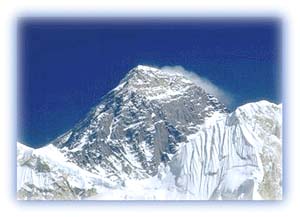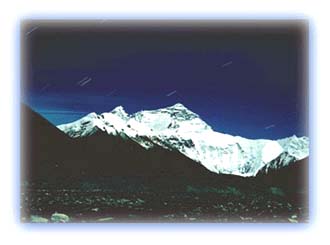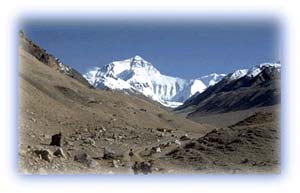Nepal Himalayas
General Info
· Solo Khumbu
· Namche Bazar
· Thyangboche
· Pangboche
· Kalapattar
· Pheriche
· Buddhism in Khumbu
· People: Sherpas
· Mount Everest
Early Years
· The 1950s
· Sherpas on Everest
· Central Nepal
· Mustang
· Jomsom
· People: Thakalis
· Muktinath
· Manang valley
· Bryagu village
· Manang village
· Nyasang Division
· Western Nepal
· Jumla
· Sukhadik
Photo Feature:
· Annapurna region
High Altitude Sickness
Endangered Species
Protected Areas
Yaks
The Yeti Factor

![]()
|
The Quest for Everest In 1590, a Spanish missionary to the court of the Mughal emperor Akbar undertook the work of mapping the Himalayas for the first time ever. However, it was only in the middle of the 19th century that the heights of the Himalayan peaks were measured correctly. In 1856, a British mapping team established Peak XV at 8,848 m (29,028 ft) as the highest point on earth. Mt Everest was given its name in 1865 in honor of surveyor Sir George Everest, who was the surveyor general of India from 1830 to 1843. |
Sir Edmund Hillary's views on Everest. (Download Realplayer) |
 |
| Everest -- a closer look Credit: Stan Armington |
The Early Years
Explorers have attempted to climb the mountain from the early
years of the 20th century. In the early years, not much was
known about the physiological effects of extreme altitude, and
mountaineers the world over had their doubts whether one could
possibly climb Mt Everest. It was a leap into the world of the
unknown, traveling to far off lands and launching huge
expeditions up the slopes of the Himalaya to altitudes no human
had ever experienced. In the early years, the initial problems
faced by these explorers was of merely gaining access to Mt
Everest, since neither Tibet nor Nepal, on either side of the
mountain, welcomed outsiders. It was only after a personal
appeal to the Dalai Lama that permission was granted for a
British expedition to visit Everest from the Tibet side in
1921. Their goal -- to find out if a route to the summit of Mt
Everest could be found. After early disasters struck, British
mountaineer George Leigh Mallory assumed responsibility for
most of the exploration carried out by this expedition.
 |
| Stars dancing around Mt Everest Credit: Matjaz Vrecko |
Why climb Everest? "Because it's there", was the classic answer of George Mallory who became legendary due to his exploits on the highest peak of the world. British expeditions attempted Everest again in the following years, and Mallory arrived in 1924, in what was to be his last attempt on Everest.
In a final attempt for the summit, Mallory was accompanied by the young Oxford University student Andrew Irvine. They were attempting the Northeast Ridge to the summit of Everest. The two mountaineers were climbing with the help of bottled oxygen and were spotted by Noel Odell towards 1 p.m. on their summit day, on a rocky outcrop on the ridge. In Odell's words they were 'going strong for the top'.
 |
| A clear view of Mount Everest Credit: Matjaz Vrecko |
But, they disappeared into the clouds and were never seen again. It is a famous mountaineering debate whether Mallory and Irvine might have actually reached the top before the men who finally climbed Mt Everest in 1953. It will forever remain one of the greatest mysteries in the history of mountaineering.
The magic of Everest. (Download Realplayer) |
Eric Shipton, one of the most well-known mountaineers in the 1930s, predicted that Everest would eventually be climbed, but he was aware of the physiological problems encountered in high altitude mountaineering. In his words, "It would seem almost as though there were a cordon drawn round the upper part of these great peaks beyond which no man may go. The truth, of course, lies in the fact that, at altitudes of 25,000 feet and beyond, the effects of low atmospheric pressure upon the human body are so severe that really difficult mountaineering is impossible and the consequences even of a mild storm may be deadly, that nothing but the most perfect conditions of weather and snow offer the slightest chance of success, and that on the last lap of the climb no party is in a position to choose its day."
All rights reserved